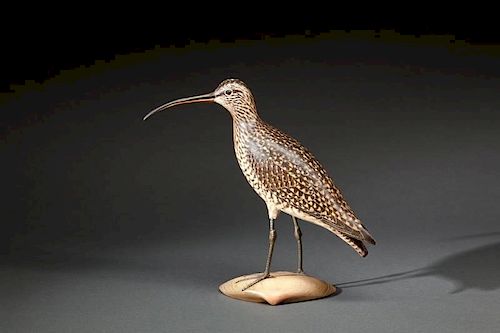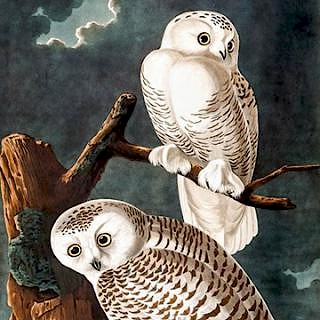Curlew
About Seller
20 Winter Street
Pembroke, MA 02359
United States
Founded in 2005, Copley Fine Art Auctions is a boutique auction house specializing in antique decoys and American, sporting, and wildlife paintings. Over the course of the last two decades, the firm has set auction records for not only individual decoy makers, but also entire carving regions. Copley...Read more
Two ways to bid:
- Leave a max absentee bid and the platform will bid on your behalf up to your maximum bid during the live auction.
- Bid live during the auction and your bids will be submitted real-time to the auctioneer.
Bid Increments
| Price | Bid Increment |
|---|---|
| $0 | $50 |
| $1,000 | $100 |
| $2,500 | $250 |
| $5,000 | $500 |
| $10,000 | $1,000 |
| $25,000 | $2,500 |
| $50,000 | $5,000 |
About Auction
Feb 12, 2015 - Feb 13, 2015
Copley Fine Art Auctions cinnie@copleyart.com
- Lot Description
A. Elmer Crowell (1862-1952), East Harwich, MA
c. 1930
A life-size shorebird mantle carving with a slightly turned head. This decorative exhibits Crowell's mastery of the carved wooden bird and his finest blended painted surface representing the plumage. Mounted on a carved clam-shell base with the maker's rectangular stamp on the bottom. The underside also displays the inscription "A. H. Dempsey to J. Ashley Dempsey," and "CR" for Carolyn Rowland.Anthony Elmer Crowell was born in 1862 in the town of East Harwich, Massachusetts, the son of a Cape Cod mariner and cranberry grower. According to Crowell in his memoires, Anthony S. Crowell, Elmer’s father, though not a hunter, gave his son his first shotgun at the age of twelve. Of the relevance of receiving the new shotgun Crowell wrote, “Then, I was some boy!” The legend of A.E. Crowell and his famous carvings has many of the common threads of the typical artist’s tale. It is the story of a boy of modest means, born at the right time, and befriended by encouraging patrons. Crowell started out in his teens as a market hunter and a pioneering keeper of live waterfowl. These passions helped Crowell to develop an intrinsic knowledge of both waterfowl and other birds. His familiarity with bird anatomy enabled Crowell to create carved wood sculptures that bear exceptional likeness to their species.
Young Elmer wasted no time immersing himself into the life of a market hunter. His father owned a small piece of property on nearby Pleasant Lake in East Harwich. By 1876, at the age of fourteen, Elmer had set up his own gunning stand along the lake’s southern shore. Crowell describes the site as having, “a fine sand beach which was ideal for my ducks. I had only six live decoys the first season. I made nine block decoys and put them off about thirty yards in the lake.” Crowell’s description reveals two important aspects regarding his career. The first being his preferred use of live birds as decoys, and the second is the documentation that he began to carve decoys by the age of fourteen.
It is often the confidence and enthusiasm of youth that brings forth great experimental breakthroughs. Crowell’s immersion into waterfowl hunting was no different. At a time when market hunters could earn a respectable living if they were able to secure enough game, necessity became the mother of invention. Crowell’s flair for handling live decoys was most certainly born of this mindset. Crowell recounted in his memoir that by 1878, less than two years after starting to hunt, he had increased his flock to, “forty live decoys and tried a new way of handling my ducks. I sank a pole with a ring in the top and ran a line through it back to the blind, which made an endless line. I tied four live ducks to it and pulled them off the pond about thirty five yards. It was about two weeks before they were broken in so I could pull them out without their making a flutter. After that they were all right.”
In the third quarter of the 19th century, Cape Cod was a major stop-over for migratory birds and sparsely populated by people. However, with increased access by train and the advent of the automobile, Cape Cod was quickly becoming a destination for sportsmen in pursuit of outdoor recreation. The concept of the American shooting sportsman was beginning to take root. The gunning stands and camps that had once been primarily operated by local market gunners were becoming increasingly sought after by sportsmen from Boston.
These newer club owners would often invite their influential and wealthy friends down as guests and they needed managers to run the camps. It was Charles Ashley Hardy of Chatham and Wayland, Massachusetts, along with his partners, G. Herbert Windeler and Loring Underwood, who first approached the enthusiastic young bird handler. It is no small coincidence that they established their camp “The Three Bears Club” on Pleasant Lake, one half mile from Crowell’s gunning stand.
The tremendous advantages that Crowell’s inventions and practices provided to the “Three Bears” cannot be overstated. Crowell’s trapdoor invention most closely resembled an automatic garage door. A domesticated flock of honking Canada geese would fly out, circle the pond, and draw the wild geese straight back to the beach like magnets. Crowell stated, “It was a success and we had good shooting for a number of years. At that time we began to bait the small ponds with corn, and two years later we baited in front of our blinds at the lake. It stopped the black ducks from going south, so the ponds were full of ducks; the shooting was great.” Crowell’s own words speak volumes and provide insight into the looming decimation of the migratory bird populations which began to occur at the turn of the century. The refined use of live decoys coupled with baiting waterfowl halted the wild birds from their natural migration patterns. Hunters were quickly becoming so adept at attracting their quarry that wild ducks and geese stood virtually no chance.
Federal regulations shortly thereafter banned the use of live decoys and forced Crowell into the world famous carver so revered today. Unable to use live domesticated birds to lure in the flocks, Crowell did the next best thing, creating exceptional sculptures of likeness in wood.
The quality of the carvings that Crowell created for his earliest patrons, including this whimbrel for the Hardy family, was often exceptional. Through experimentation he developed and mastered his “wet-on-wet” dry brush feathering technique. While the darker brown feather paint was still wet Crowell applied the lighter feather delineations. Once the two different colored paints became tacky, he took a clean dry brush and gently feathered the two colors together, producing a nicely blended affect. One has the sense that Crowell was either looking right at a real curlew as he painted this carving or he had handled so many that their shapes and feather patterns were etched in his memory.
The special relationships forged through hunting, beginning with Charles Hardy, Dr. Phillips, Harry V. Long and others, opened the world to Crowell’s workshop, and the customers came knocking. Crowell specifically credits Mrs. Alexis Felix DuPont for introducing his work to many of the affluent summer residents of Chatham and other important patrons including Joseph B. Chace, Stuart Crocker, Dr. Mac Cunningham, Henry Ford, Arthur Gould, John D. Rockefeller Jr., and Abby Aldrich Rockefeller.
Provenance: Alison Hardy Dempsey CollectionJane Ashley Dempsey Collection
Carolyn Rowland Collection
Private Collection
Literature: Copley Fine Art Auctions, LLC, "The Harry V. Long Collection of A. Elmer Crowell Decoys", The Sporting Sale, Boston, MA, 2009.Brian Cullity, "The Songless Aviary," Sandwich, MA, 1992, p. 26, similar example illustrated.
Condition: Original paint with minimal wear, touch-up to the legs, and the lower half of the bill has been professionally restored.Condition
- Shipping Info
-
Shipping info
Copley Fine Art Auctions does not handle the shipping of any items. Shipping is the sole responsibility of the buyer. Once your payment has cleared, and we have received your authorized shipping release form items may be released for shipment. Copley Fine Art Auctions, LLC shall have no liability for any loss or damage to such items. Buyers should allow up to four weeks for shipment.PLEASE BE AWARE THAT INTERNET BIDDERS MAY NOT PICK UP THEIR ITEMS AT THE SALE SITE. ITEMS CAN BE PICKED UP BY APPOINTMENT OR SHIPPED STARTING FIVE DAYS AFTER THE CONCLUSION OF THE SALE
-
- Buyer's Premium



 EUR
EUR CAD
CAD AUD
AUD GBP
GBP MXN
MXN HKD
HKD CNY
CNY MYR
MYR SEK
SEK SGD
SGD CHF
CHF THB
THB













